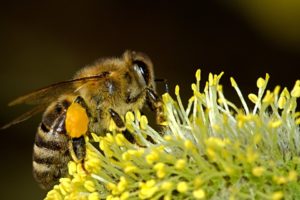11
May
Judge Rules that EPA Neonicotinoid Registrations Violated Endangered Species Act
(Beyond Pesticides, May 11, 2017) On Monday, a federal judge in California ruled that the U.S. Environmental Protection Agency (EPA) violated the Endangered Species Act (ESA) when it issued 59 neonicotinoid insecticide registrations between 2007 and 2012 for pesticide products containing clothianidin and thiamethoxam. The original lawsuit against EPA, Ellis v. Housenger, was filed in March 2013, by beekeeper Steve Ellis and a coalition of other beekeepers and environmental groups, including Beyond Pesticides. The 2013 lawsuit focused on the EPA’s failure to protect pollinators from dangerous pesticides and challenged EPA’s oversight of the bee-killing pesticides, clothianidin and thiamethoxam, as well as the agency’s practice of “conditional registration” and labeling deficiencies.

According to George Kimbrell, Center for Food Safety’s legal director and the lead plaintiffs’ counsel, “This is a vital victory. Science shows these toxic pesticides harm bees, endangered species and the broader environment. More than fifty years ago, Rachel Carson warned us to avoid such toxic chemicals, and the court’s ruling may bring us one step closer to preventing another Silent Spring.”
The judge presiding over the case rejected claims by pesticide producers and their supporters that the plaintiffs failed to establish a causal link between the pesticides and the plaintiffs’ injury. U.S. District Judge Maxine Chesney did not order EPA to consult with the U.S. Fish and Wildlife Service (FWS) and National Marine Fisheries Service (NMFS), which is required when registering a pesticide in order to mitigate risks to endangered species. Instead, she directed the parties, including the plaintiffs, defendant EPA, and intervenor Bayer CropScience, to move forward with a settlement conference to resolve the disputes. Thus, additional proceedings will follow the decision to assess the proper solution for EPA’s violations, which may lead to cancellations of the 59 pesticide registrations, including agricultural products such as seed-coating insecticides.
“Vast amounts of scientific literature show the hazards these chemicals pose are far worse than we knew five years ago – and it was bad even then,” said Center for Food Safety attorney Peter Jenkins, who was involved in the proceedings. “The nation’s beekeepers continue to suffer unacceptable mortality of 40 percent annually and higher. EPA must act to protect bees and the environment.”
The recent ruling denied other claims in the lawsuit that were based on the plaintiffs’ emergency legal petition made in March 2012, because the court lacked jurisdiction due to conflicting laws or EPA’s actions were not “approvals” subject to court challenge. Beyond Pesticides, along with numerous commercial beekeepers and environmental organizations filed this petition with EPA to suspend use of a pesticide that is linked to honey bee deaths, urging the agency to adopt safeguards. The legal petition, which specified the pesticide clothianidin, was supported by over one million citizen petition signatures and targeted the pesticide for its harmful impacts on honey bees.
This ruling comes at a time when neonicotinoid-treated seeds are pervasive and widely used across the agricultural landscape, home gardens, and public spaces. Of the two most widely planted crops in the United States, between 79 to 100 percent of corn seed and 34 to 44 percent of soybean seed were treated with neonics in 2011. A conservative estimate of the area planted with neonic-treated corn, soybean, and cotton seed totals just over 100 million acres, or 57 percent of the entire area for these crops.
Systemic neonicotinoid pesticides, which include clothianidin and thiamethoxam, move through the plant’s vascular system and are expressed through pollen, nectar, and guttation droplets. These pesticides have been found by a growing body of scientific literature to be linked to pollinator decline in general. Neonics are associated with decreased foraging and navigational ability, as well as increased vulnerability to pathogens and parasites as a result of suppressed bee immune systems. While the benefits to farmers are insignificant, the harm neonicotinoids cause to the wider environment is of serious concern. The dust released from planting coated seeds can drift off-field and contaminate field margins with high levels of these toxic pesticides. The Center for Food Safety’s report, Net Loss, cites findings that, depending on the crop, only five percent of the active chemical in a seed coating actually enters a crop. The other 95% of the chemical makes its way into the environment, either through seed dust, soil contamination, or water runoff.
In light of the shortcomings of federal action to protect pollinators, it is left up to us to ensure that we provide safe havens by creating pesticide-free habitat and educating others to do the same. You can pledge your green space as pesticide-free and pollinator-friendly. It does not matter how large or small your pledge is, as long as you contribute to the creation of safe pollinator habitat. Sign the pledge today.
Show appreciation for both wild and managed pollinators by taking local action. Get involved at the community level to pass policies that protect imperiled pollinators. Right now, without federal protection, the rusty patched bumblebee needs concerned communities throughout the country to step in and makes changes that give it a fighting chance. Use Beyond Pesticides’ resources and educational materials, including our BEE Protective doorknob hangers to get the word out. And be sure follow Beyond Pesticides’ ongoing series celebrating unsung wild pollinator heroes through the Polli-NATION campaign.
Sources: Center for Food Safety, Courthouse News Service
All unattributed positions and opinions in this piece are those of Beyond Pesticides.










